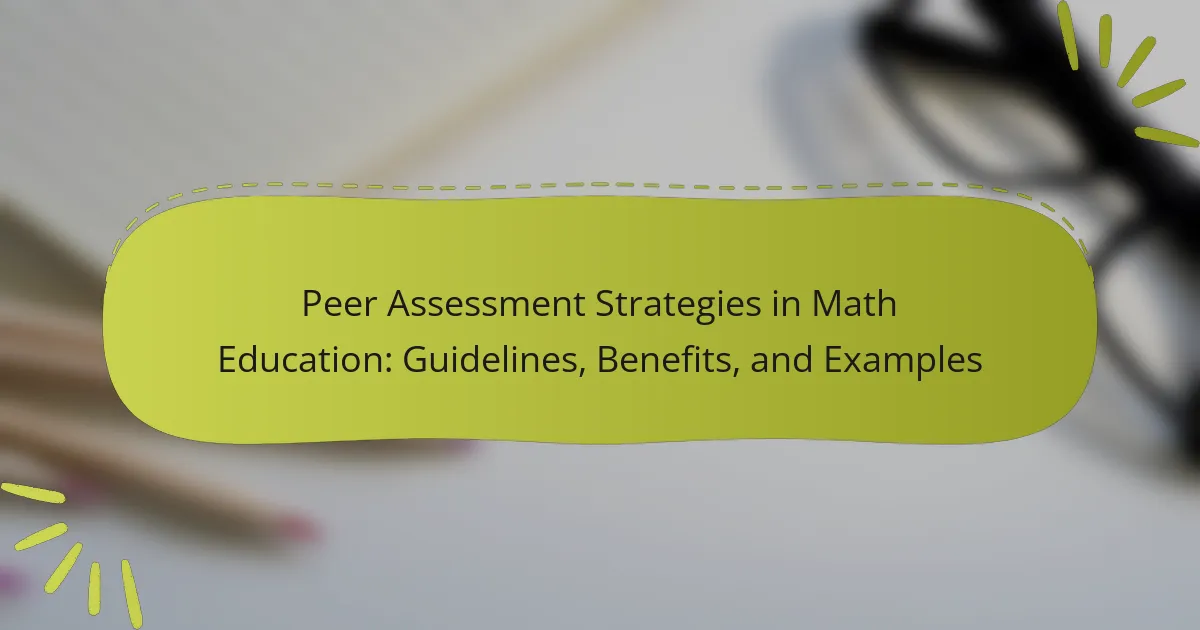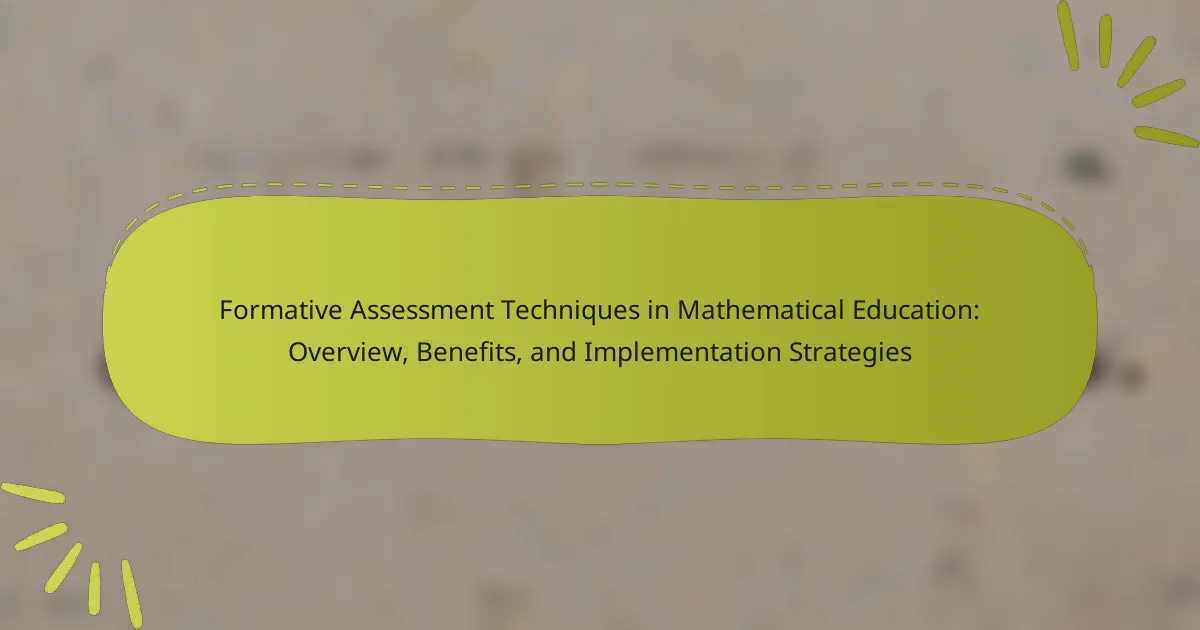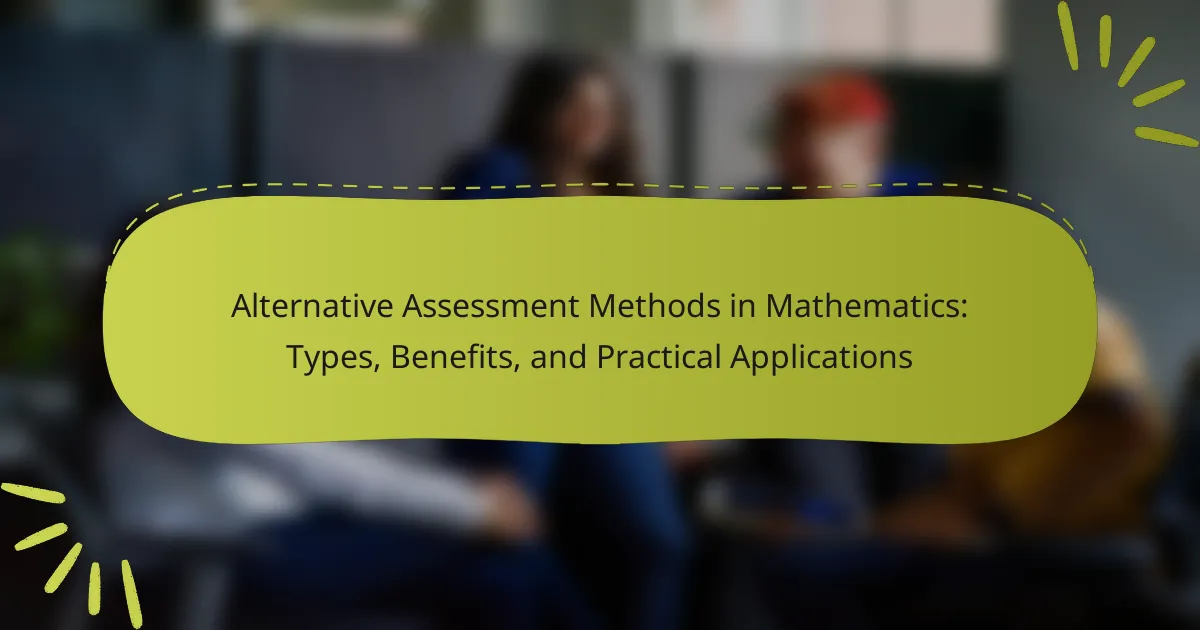Summative assessment methods for math learning evaluate student understanding at the conclusion of an instructional period. These methods include standardized tests, final exams, and cumulative projects, measuring knowledge retention and skill application while providing insights into student performance relative to learning objectives. The article outlines effective implementation strategies, such as aligning assessments with learning goals and using diverse formats to accommodate various learning styles. It also addresses challenges associated with summative assessments, including limited scope, student pressure, and potential bias, while emphasizing the importance of regular feedback and data analysis for instructional improvement.

What are Summative Assessment Methods for Math Learning?
Summative assessment methods for math learning evaluate student understanding at the end of an instructional period. Common methods include standardized tests, final exams, and cumulative projects. These assessments measure knowledge retention and skill application. They provide a snapshot of student performance against learning objectives. Data from summative assessments can inform curriculum adjustments. Research indicates that these methods help identify areas needing improvement. They also contribute to accountability in educational settings. Summative assessments typically occur after a unit or course completion.
How do summative assessments differ from formative assessments?
Summative assessments evaluate student learning at the end of an instructional unit. They measure the extent of knowledge gained and are often used for grading purposes. Examples include final exams and standardized tests. Formative assessments, on the other hand, are conducted during the learning process. They provide ongoing feedback to improve student learning and inform instruction. Examples include quizzes, discussions, and homework assignments. Summative assessments are typically high stakes, while formative assessments are low stakes. Research shows that formative assessments can significantly enhance student achievement by offering timely feedback.
What are the key characteristics that define summative assessments?
Summative assessments are evaluations that measure student learning at the end of an instructional unit. They are typically used to determine if learning objectives have been met. These assessments often take the form of tests, projects, or presentations. They provide a comprehensive overview of student performance. Summative assessments are usually graded and contribute to final grades. They can inform future teaching strategies and curriculum adjustments. Research shows that summative assessments help in evaluating the effectiveness of educational programs. They are distinct from formative assessments, which are ongoing and aimed at improving learning during the instructional process.
Why is it important to differentiate between assessment types?
Differentiating between assessment types is crucial for effective educational outcomes. Each assessment type serves distinct purposes and provides specific insights into student learning. For example, formative assessments help track progress during the learning process. In contrast, summative assessments evaluate overall understanding at the end of a learning period. Understanding these differences allows educators to choose appropriate methods for their teaching goals. Research indicates that tailored assessments can improve student performance by aligning with learning objectives. Therefore, recognizing the nuances among assessment types enhances instructional strategies and supports student success.
What are the primary types of summative assessment methods in math learning?
The primary types of summative assessment methods in math learning include standardized tests, final exams, and performance assessments. Standardized tests provide a uniform measure of student learning across different schools. Final exams assess cumulative knowledge at the end of a course. Performance assessments evaluate students’ abilities to apply math concepts in real-world scenarios. Each method offers a structured way to gauge student understanding and mastery of math skills. Research shows that combining these methods can provide a more comprehensive evaluation of student performance.
What is the role of standardized tests in assessing math learning?
Standardized tests play a critical role in assessing math learning by providing a uniform measure of student performance. These tests evaluate students’ understanding of math concepts and skills across various grade levels. They offer a comparison point among students, schools, and districts. Standardized tests can identify areas of strength and weakness in math proficiency. Data from these assessments can inform instructional strategies and curriculum adjustments. Research shows that standardized tests can predict future academic success in math. For example, the National Assessment of Educational Progress (NAEP) provides insights into national math achievement trends. Overall, standardized tests serve as a valuable tool for educators to gauge math learning outcomes effectively.
How do projects and presentations serve as summative assessments?
Projects and presentations serve as summative assessments by evaluating students’ understanding and application of knowledge. They require students to synthesize information and demonstrate mastery of concepts. These assessments provide a comprehensive view of a student’s learning progress. They encourage critical thinking and problem-solving skills. Projects often involve real-world applications, making learning relevant. Presentations allow students to articulate their understanding clearly. Research indicates that such assessments can improve retention of information. According to a study by Thomas (2000), project-based assessments enhance student engagement and learning outcomes.
What are the benefits of using portfolios in math assessment?
Portfolios in math assessment provide a comprehensive view of a student’s learning progress. They showcase a collection of student work over time. This method allows for the demonstration of understanding and application of mathematical concepts. Portfolios encourage reflection on learning and self-assessment. They foster a deeper engagement with the material. Research indicates that portfolios can improve student motivation and ownership of learning. A study by D. H. Schunk (2003) found that self-assessment through portfolios enhances academic performance. Therefore, using portfolios in math assessment is beneficial for tracking growth and encouraging active learning.
What advantages do summative assessment methods offer for math learning?
Summative assessment methods provide several advantages for math learning. They evaluate student understanding at the end of an instructional period. This evaluation helps identify overall student performance and learning gaps. Summative assessments can guide future instruction by highlighting areas needing improvement. They also offer a structured way to measure student progress against curriculum standards. Research shows that these assessments can motivate students by providing clear goals. Additionally, they allow for comparison of student performance across different classes or schools. Overall, summative assessments contribute to a comprehensive understanding of student learning outcomes in mathematics.
How do summative assessments contribute to measuring student learning outcomes?
Summative assessments measure student learning outcomes by evaluating knowledge at the end of an instructional period. These assessments provide a comprehensive overview of what students have learned. They typically include final exams, projects, or standardized tests. Such assessments help educators determine the effectiveness of their teaching methods. They also identify areas where students excel or struggle. Research shows that well-designed summative assessments can accurately reflect students’ understanding of the material. For instance, a study by Black and Wiliam (1998) highlights that effective assessments can significantly improve learning outcomes. Thus, summative assessments are essential tools for measuring educational success.
What impact do these assessments have on instructional planning?
Summative assessments significantly influence instructional planning by providing data on student learning outcomes. These assessments help educators identify areas where students excel or struggle. Consequently, teachers can adjust their instructional strategies to meet diverse learning needs. For instance, data from assessments can lead to the modification of lesson plans, pacing, and resource allocation. Research indicates that targeted instructional adjustments based on assessment results can enhance student performance. A study by Black and Wiliam (1998) found that formative feedback from assessments can improve learning outcomes. Thus, summative assessments are crucial for effective instructional planning in math education.
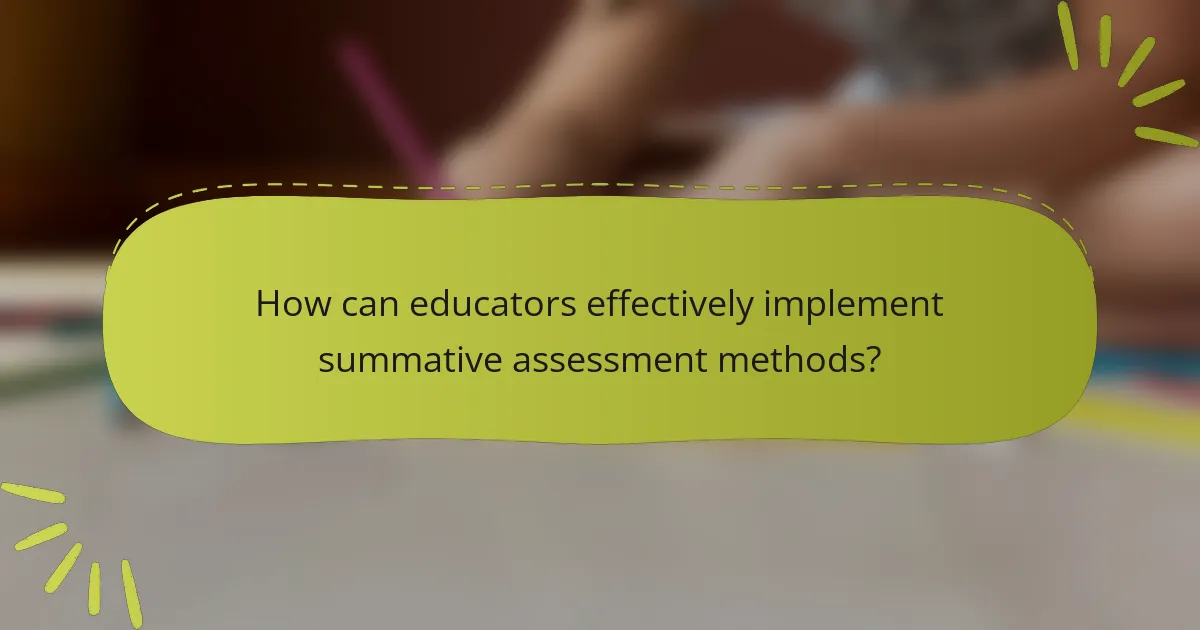
How can educators effectively implement summative assessment methods?
Educators can effectively implement summative assessment methods by clearly defining learning objectives. They should align assessments with these objectives to measure student understanding accurately. Utilizing a variety of assessment formats, such as tests, projects, and presentations, can cater to different learning styles. Providing clear rubrics helps students understand expectations and grading criteria.
Regular feedback during the learning process supports student improvement before the final assessment. Analyzing assessment data can guide instructional adjustments and identify areas needing reinforcement. Training educators on effective assessment design enhances the quality and reliability of assessments. Implementing summative assessments at the end of instructional units allows for comprehensive evaluation of student learning.
What best practices should educators follow when designing summative assessments?
Educators should ensure summative assessments align with learning objectives. This alignment guarantees that assessments measure what students are expected to learn. Clear criteria for success should be established. This allows students to understand expectations and performance standards. Variety in assessment formats is essential. Using tests, projects, and presentations caters to diverse learning styles.
Feedback mechanisms should be incorporated. Providing students with insights on their performance promotes growth. Assessments should be reliable and valid. This ensures consistent results across different contexts and accurately measures student learning. Lastly, educators should review and revise assessments regularly. This practice ensures they remain relevant and effective in measuring student understanding.
How can alignment with learning objectives enhance assessment effectiveness?
Alignment with learning objectives enhances assessment effectiveness by ensuring that assessments measure what students are expected to learn. This alignment creates a clear connection between teaching and evaluation. When assessments reflect learning objectives, they provide meaningful feedback on student progress. Research shows that aligned assessments improve student outcomes by fostering deeper understanding. A study by Hattie (2009) indicates that clarity in learning goals significantly boosts student achievement. Furthermore, alignment helps educators identify gaps in knowledge and adjust instruction accordingly. This process leads to more targeted teaching strategies that support student learning. Therefore, alignment with learning objectives is crucial for effective assessment practices.
What strategies can be used to ensure fairness and accessibility in assessments?
To ensure fairness and accessibility in assessments, implement varied assessment methods. Diverse formats cater to different learning styles and needs. Incorporate accommodations for students with disabilities. This may include extended time or alternative formats. Use clear, unbiased language in assessment items. Avoid cultural or socio-economic biases that may disadvantage certain groups. Provide practice assessments to familiarize students with the format. This reduces anxiety and promotes equity. Regularly review and update assessment practices based on feedback. Research indicates that inclusive assessments improve overall student performance (Gordon, 2018, “Equity in Assessment”).
How can educators analyze and interpret summative assessment results?
Educators can analyze and interpret summative assessment results by employing various data analysis techniques. They should first gather quantitative data from assessments, such as test scores and completion rates. Next, educators can categorize results to identify trends in student performance. They should compare results against benchmarks or standards to evaluate learning outcomes. Analyzing item-level data helps identify specific areas of strength or weakness in student understanding. Additionally, educators can use qualitative feedback from assessments to gain insights into student learning experiences. Utilizing statistical methods, such as mean and standard deviation, can provide further context to the data. Engaging in collaborative discussions with colleagues can enhance the interpretation of results. Ultimately, these methods help educators make informed decisions to improve instructional strategies and support student learning.
What methods can be used to evaluate student performance data?
Methods to evaluate student performance data include standardized tests, formative assessments, and summative assessments. Standardized tests provide a consistent measure of student knowledge across different populations. Formative assessments, such as quizzes and classroom activities, monitor student progress during the learning process. Summative assessments, including final exams and projects, evaluate cumulative knowledge at the end of an instructional period. Each method offers insights into student understanding and areas needing improvement. Utilizing a combination of these methods allows educators to gain a comprehensive view of student performance.
How can feedback from assessments inform future teaching practices?
Feedback from assessments can significantly inform future teaching practices. It identifies students’ strengths and weaknesses. Teachers can adjust their instructional strategies based on this feedback. For instance, if many students struggle with a particular concept, the teacher may revisit that topic. This targeted approach enhances student understanding. Additionally, feedback helps in curriculum planning. Teachers can modify lesson plans to better align with student needs. Research shows that formative feedback can lead to a 20% increase in student performance (Hattie & Timperley, 2007). Thus, using assessment feedback effectively can lead to improved educational outcomes.
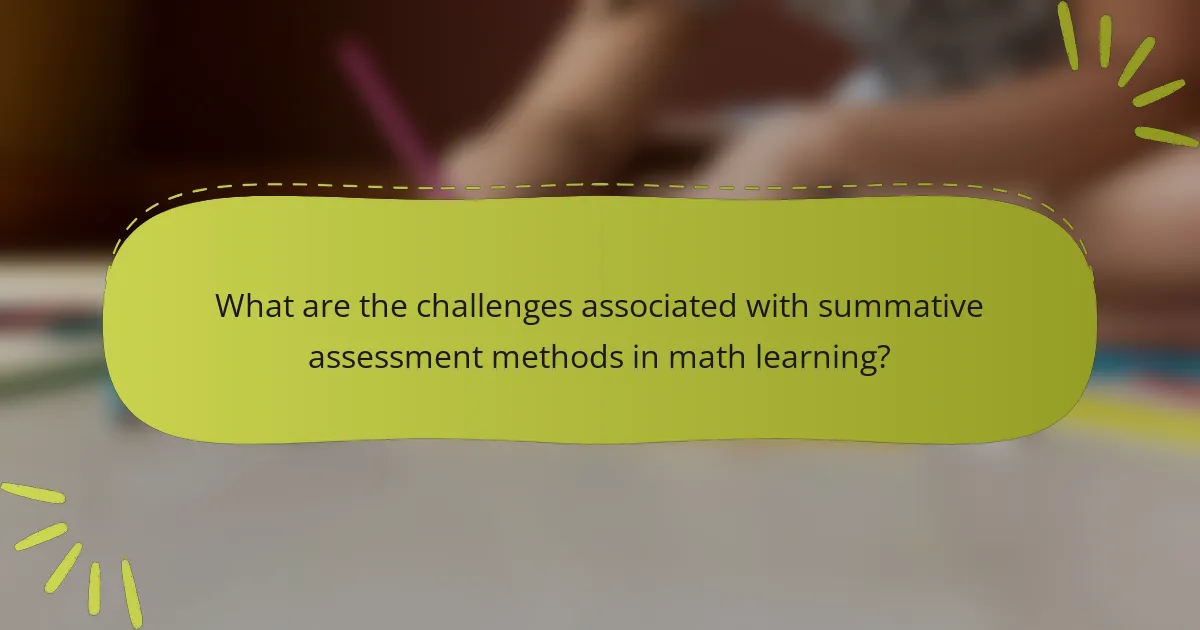
What are the challenges associated with summative assessment methods in math learning?
Summative assessment methods in math learning face several challenges. One challenge is the limited scope of assessment. These methods often evaluate only a narrow range of skills. This can lead to an incomplete understanding of a student’s abilities. Another challenge is the pressure on students. High-stakes testing can induce anxiety, affecting performance. Additionally, summative assessments may not reflect real-world applications. They often focus on rote memorization rather than problem-solving skills. There is also a potential for bias. Some assessments may not accommodate diverse learning styles. Finally, the timing of assessments can be problematic. They typically occur at the end of a learning period, making it difficult to address gaps in knowledge.
What common pitfalls should educators avoid when using summative assessments?
Educators should avoid several common pitfalls when using summative assessments. One major pitfall is relying solely on a single assessment to determine student understanding. This can lead to an inaccurate representation of a student’s abilities. Another common mistake is not aligning assessments with learning objectives. Misalignment can result in assessing irrelevant knowledge or skills.
Additionally, educators should avoid using assessments that are too challenging or not appropriately leveled. This can discourage students and lead to disengagement. Another issue is failing to provide timely feedback after the assessment. Without feedback, students miss opportunities for growth and improvement.
Finally, educators should avoid using assessments as the only measure of student success. A holistic approach that includes formative assessments offers a more comprehensive view of student learning. Research indicates that varied assessment methods enhance learning outcomes (Black & Wiliam, 1998).
How can over-reliance on summative assessments impact student learning?
Over-reliance on summative assessments can negatively impact student learning. This approach often prioritizes final evaluations over ongoing feedback. Students may focus solely on grades rather than understanding the material. This can lead to shallow learning, where students memorize information without grasping concepts. Research indicates that frequent formative assessments improve retention and comprehension. A study by Black and Wiliam (1998) shows that formative feedback enhances student achievement significantly. Thus, relying heavily on summative assessments may hinder deeper learning and critical thinking skills.
What are the limitations of traditional testing methods in math?
Traditional testing methods in math have several limitations. They often emphasize rote memorization over critical thinking. This approach can hinder a student’s ability to apply concepts in real-world situations. Traditional tests typically assess only a narrow range of skills. They may not capture a student’s full understanding or problem-solving abilities. Additionally, these tests can induce anxiety, affecting performance. Research shows that high-stakes testing can disproportionately impact disadvantaged students. Furthermore, traditional assessments usually provide limited feedback for improvement. They often lack opportunities for students to demonstrate their knowledge in diverse ways.
What innovative approaches can enhance summative assessment methods?
Innovative approaches that can enhance summative assessment methods include the integration of technology and formative assessments. Technology can facilitate online assessments, allowing for immediate feedback. This immediate feedback can improve student understanding and retention of material. Formative assessments, such as quizzes and peer reviews, can provide insights into student learning before the final assessment. Research shows that combining formative and summative assessments leads to better learning outcomes. A study by Black and Wiliam (1998) found that formative assessment significantly enhances student achievement. Additionally, project-based assessments can promote critical thinking and real-world application of math concepts. These innovative approaches make summative assessments more effective and reflective of student learning.
How can technology be integrated into summative assessments?
Technology can be integrated into summative assessments through various digital tools and platforms. Online testing systems enable automated grading and instant feedback. Learning management systems can facilitate the submission and tracking of assessments. Interactive software allows for the creation of dynamic assessment formats, such as simulations and quizzes. Data analytics tools can analyze student performance trends over time. These integrations enhance accessibility and engagement for learners. Research shows that technology in assessments can improve learning outcomes by providing immediate insights into student understanding.
What role does peer assessment play in the summative assessment process?
Peer assessment plays a significant role in the summative assessment process by enhancing student engagement and understanding. It allows students to evaluate each other’s work, fostering critical thinking and reflective skills. This collaborative approach encourages deeper learning as students articulate their reasoning and feedback. Research indicates that peer assessment can lead to improved academic performance. A study by Topping (1998) found that students who participated in peer assessments showed increased motivation and higher achievement levels. Thus, peer assessment not only aids in evaluating student performance but also enriches the learning experience in summative assessments.
What practical tips can educators use to improve summative assessments in math learning?
Educators can improve summative assessments in math learning by incorporating varied assessment formats. This includes using multiple-choice questions, open-ended problems, and performance tasks. Each format targets different skills and knowledge levels. Additionally, providing clear rubrics enhances transparency in grading. Rubrics help students understand expectations and improve their performance. Furthermore, integrating real-world applications makes assessments more relevant. When students see practical use, their engagement increases. Regular feedback on assessments also aids in student learning. It allows for reflection and improvement in future assessments. Lastly, involving students in the assessment design can foster ownership. This approach encourages them to take an active role in their learning.
Summative assessment methods for math learning evaluate student understanding at the end of an instructional period, utilizing standardized tests, final exams, and cumulative projects. These assessments provide insights into knowledge retention and skill application, helping identify areas for improvement and informing curriculum adjustments. The article explores the differences between summative and formative assessments, key characteristics of summative assessments, and various types, including their advantages and challenges. It also discusses best practices for implementation, the importance of alignment with learning objectives, and innovative approaches to enhance assessment effectiveness.
